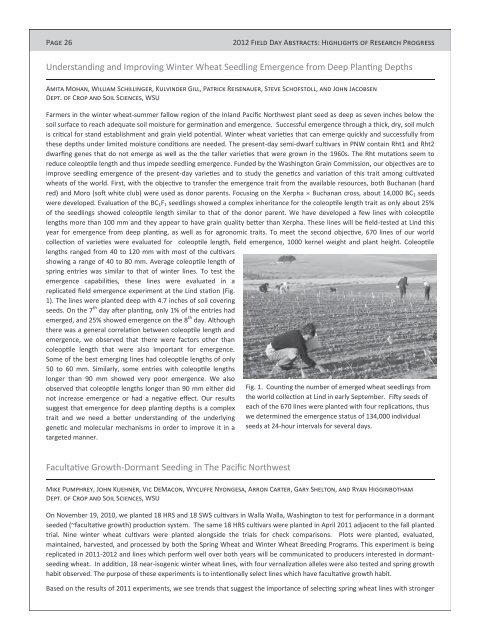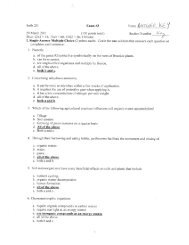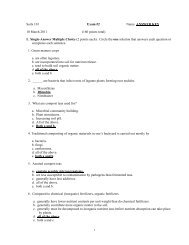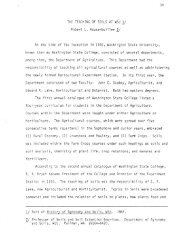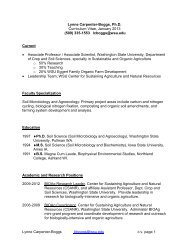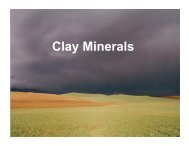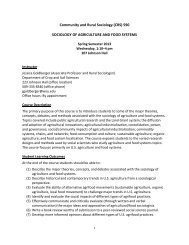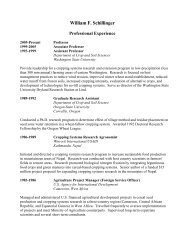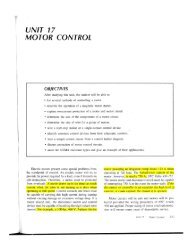2012 Dryland Field Day Abstracts - Dept. of Crop and Soil Sciences ...
2012 Dryland Field Day Abstracts - Dept. of Crop and Soil Sciences ...
2012 Dryland Field Day Abstracts - Dept. of Crop and Soil Sciences ...
You also want an ePaper? Increase the reach of your titles
YUMPU automatically turns print PDFs into web optimized ePapers that Google loves.
Page 26<br />
<strong>2012</strong> <strong>Field</strong> <strong>Day</strong> <strong>Abstracts</strong>: Highlights <strong>of</strong> Research Progress<br />
Underst<strong>and</strong>ing <strong>and</strong> Improving Winter Wheat Seedling Emergence from Deep Planting <strong>Dept</strong>hs<br />
Amita Mohan, William Schillinger, Kulvinder Gill, Patrick Reisenauer, Steve Sch<strong>of</strong>stoll, <strong>and</strong> John Jacobsen<br />
<strong>Dept</strong>. <strong>of</strong> <strong>Crop</strong> <strong>and</strong> <strong>Soil</strong> <strong>Sciences</strong>, WSU<br />
Farmers in the winter wheat-summer fallow region <strong>of</strong> the Inl<strong>and</strong> Pacific Northwest plant seed as deep as seven inches below the<br />
soil surface to reach adequate soil moisture for germination <strong>and</strong> emergence. Successful emergence through a thick, dry, soil mulch<br />
is critical for st<strong>and</strong> establishment <strong>and</strong> grain yield potential. Winter wheat varieties that can emerge quickly <strong>and</strong> successfully from<br />
these depths under limited moisture conditions are needed. The present-day semi-dwarf cultivars in PNW contain Rht1 <strong>and</strong> Rht2<br />
dwarfing genes that do not emerge as well as the the taller varieties that were grown in the 1960s. The Rht mutations seem to<br />
reduce coleoptile length <strong>and</strong> thus impede seedling emergence. Funded by the Washington Grain Commission, our objectives are to<br />
improve seedling emergence <strong>of</strong> the present-day varieties <strong>and</strong> to study the genetics <strong>and</strong> variation <strong>of</strong> this trait among cultivated<br />
wheats <strong>of</strong> the world. First, with the objective to transfer the emergence trait from the available resources, both Buchanan (hard<br />
red) <strong>and</strong> Moro (s<strong>of</strong>t white club) were used as donor parents. Focusing on the Xerpha Buchanan cross, about 14,000 BC1 seeds<br />
were developed. Evaluation <strong>of</strong> the BC1F1 seedlings showed a complex inheritance for the coleoptile length trait as only about 25%<br />
<strong>of</strong> the seedlings showed coleoptile length similar to that <strong>of</strong> the donor parent. We have developed a few lines with coleoptile<br />
lengths more than 100 mm <strong>and</strong> they appear to have grain quality better than Xerpha. These lines will be field-tested at Lind this<br />
year for emergence from deep planting, as well as for agronomic traits. To meet the second objective, 670 lines <strong>of</strong> our world<br />
collection <strong>of</strong> varieties were evaluated for coleoptile length, field emergence, 1000 kernel weight <strong>and</strong> plant height. Coleoptile<br />
lengths ranged from 40 to 120 mm with most <strong>of</strong> the cultivars<br />
showing a range <strong>of</strong> 40 to 80 mm. Average coleoptile length <strong>of</strong><br />
spring entries was similar to that <strong>of</strong> winter lines. To test the<br />
emergence capabilities, these lines were evaluated in a<br />
replicated field emergence experiment at the Lind station (Fig.<br />
1). The lines were planted deep with 4.7 inches <strong>of</strong> soil covering<br />
seeds. On the 7 th day after planting, only 1% <strong>of</strong> the entries had<br />
emerged, <strong>and</strong> 25% showed emergence on the 8 th day. Although<br />
there was a general correlation between coleoptile length <strong>and</strong><br />
emergence, we observed that there were factors other than<br />
coleoptile length that were also important for emergence.<br />
Some <strong>of</strong> the best emerging lines had coleoptile lengths <strong>of</strong> only<br />
50 to 60 mm. Similarly, some entries with coleoptile lengths<br />
longer than 90 mm showed very poor emergence. We also<br />
observed that coleoptile lengths longer than 90 mm either did<br />
not increase emergence or had a negative effect. Our results<br />
suggest that emergence for deep planting depths is a complex<br />
trait <strong>and</strong> we need a better underst<strong>and</strong>ing <strong>of</strong> the underlying<br />
genetic <strong>and</strong> molecular mechanisms in order to improve it in a<br />
targeted manner.<br />
Facultative Growth-Dormant Seeding in The Pacific Northwest<br />
Fig. 1. Counting the number <strong>of</strong> emerged wheat seedlings from<br />
the world collection at Lind in early September. Fifty seeds <strong>of</strong><br />
each <strong>of</strong> the 670 lines were planted with four replications, thus<br />
we determined the emergence status <strong>of</strong> 134,000 individual<br />
seeds at 24-hour intervals for several days.<br />
Mike Pumphrey, John Kuehner, Vic DeMacon, Wycliffe Nyongesa, Arron Carter, Gary Shelton, <strong>and</strong> Ryan Higginbotham<br />
<strong>Dept</strong>. <strong>of</strong> <strong>Crop</strong> <strong>and</strong> <strong>Soil</strong> <strong>Sciences</strong>, WSU<br />
On November 19, 2010, we planted 18 HRS <strong>and</strong> 18 SWS cultivars in Walla Walla, Washington to test for performance in a dormant<br />
seeded (~facultative growth) production system. The same 18 HRS cultivars were planted in April 2011 adjacent to the fall planted<br />
trial. Nine winter wheat cultivars were planted alongside the trials for check comparisons. Plots were planted, evaluated,<br />
maintained, harvested, <strong>and</strong> processed by both the Spring Wheat <strong>and</strong> Winter Wheat Breeding Programs. This experiment is being<br />
replicated in 2011-<strong>2012</strong> <strong>and</strong> lines which perform well over both years will be communicated to producers interested in dormantseeding<br />
wheat. In addition, 18 near-isogenic winter wheat lines, with four vernalization alleles were also tested <strong>and</strong> spring growth<br />
habit observed. The purpose <strong>of</strong> these experiments is to intentionally select lines which have facultative growth habit.<br />
Based on the results <strong>of</strong> 2011 experiments, we see trends that suggest the importance <strong>of</strong> selecting spring wheat lines with stronger


